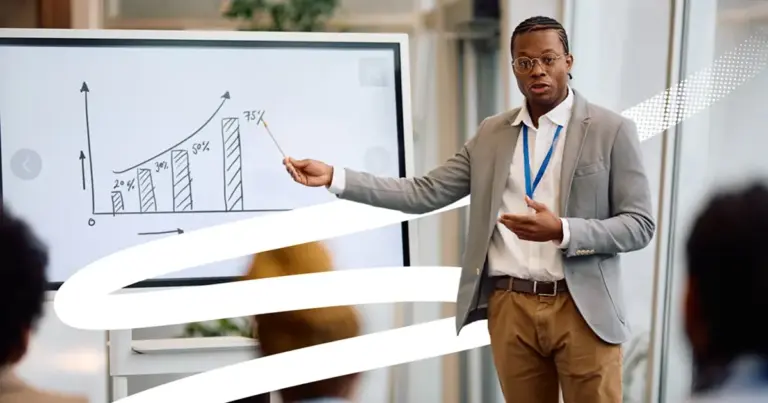Transformative learning
This article will provide you with a clear understanding of transformative learning and how to apply it in your workspace.

Implementing transformative learning in training and coaching sessions is beneficial since it fastens the pace at which employees grasp the necessary information.
After reading this content, you will get a clear understanding of transformative learning and how this theory was developed.
This content also gives you an idea of how to apply transformative learning in the workplace to create a transformation in your employees.
Discover:
- What is transformative learning?
- What is a transformative learning experience?
- Importance of transformative learning
- Benefits of transformative learning
- Transformative learning theory
- Essential components of the transformative learning theory
- Principles of the transformative theory
- Transformative learning phases according to Mezirow
- Applications of transformative learning theory
- Transformative learning examples
What is transformative learning?
Transformative learning is the expansion of consciousness through which an individual can question themselves about their own feelings, beliefs, assumptions, and perspective on their purpose.
Individuals who are undergoing such a transformative process are believed to completely rewire and transform their beliefs, assumptions, and experiences into brand new expressive perspectives.
As a theory, transformative learning is an act that individuals conduct in order to be more self-motivated, self-governing, rational, collaborative, and empathetic.
Essentially, individuals often develop the ability to reflect on things that they may have taken for granted or were not quite aware of in the past, and have made conscious decisions about it.
What is a transformative learning experience?
The transformative learning experience can vary from case to case and is certainly not limited to a particular scenario.
As an example, it can be anything from an adult who transforms their ability to spread their opinion after learning how to use social networks and the internet to a person who has a transformative experience on the way they view life due to a traumatic experience.
Importance of transformative learning
When it comes to business, transformative learning can bring a range of different benefits to adults who desire to be successful in their field.
As discussed previously, transformative learning can help an individual to be more critical, autonomous, and ultimately responsible.
Benefits of transformative learning
1. Better problem-solving applications
Critical reflection and experiences are highly important when it comes to providing basic scientific competencies.
In addition, competencies acquired with transformative learning are powerful enough to accelerate scientific investigations in terms of providing competencies that are needed at the workplace.
2. Changing habitual perspectives
A great leader in a company is someone that is always admired by his or her colleagues for a range of different characteristics.
Those characteristics can range from personality and behavior, to work ethic and determination.
Such role models can have a significant impact on employees’ habitual perspectives, and thus, transformative learning theory is often needed for the training of this role model.
3. Struggling with developmental and reriodical transition problems
As mentioned before, there are some transition points in the life process and the following periods that may not be accomplished with previous perspectives.
Adjusting these periods is possible only with critical reflection and perspective transformation method, thus, it is possible with a reconstruction of life.
4. Job and workplace adaptation
There are some transition periods in life that require transformative learning, likewise, there are various transition points in work and social life and they may not be put to an end with traditional thoughts and actions.
People may overcome problems such as adapting to job and workplace, promotion stages, change of job, and retirement only with transformative learning.
Thus, transformative learning approaches are often required for society development models and applications, which will be performed together with the contributions of native society, entrepreneurs, and cooperators.
5. Social education projects
Transformative learning may be beneficial for applications where contemporary individuals are more effective, critical, and creative such as post-migration adaptation to the city, adoption of a democratic way of life, being active in participation in civil society.
Critical reflection is the basic competency for accomplishment in applications. These education applications will be effective in solving problems that are rooted and have gotten into a vicious circle.
A widely known matter by professional educators is that necessary and unavoidable transformation isn’t able to occur as long as learning, understanding, and application aren’t changed.
Acquiring rational and emotional skills are the main purpose in transformative learning in order to make a critical reflection by developing new perspectives and meaning structure.
This purpose gives clues about learning techniques and activities to be applied.
Transformative learning theory
This theory results in changes to viewpoints, expectations, and assumptions after a transformative experience or situation. Jack Mezirow initially developed this theory.
Jack Mezirow’s
Jack Mezirow was an American sociologist continuing Education at Teachers College, Columbia University.
He was also an Emeritus Professor of Adult who received his B.A. and M.A. Degree in Social Sciences and Education from the University of Minnesota. He sadly passed away in September 2014.
He left us with the transformative theory he developed back in 2000. He began this theory in 1978 while studying adult women that chose to re-enter higher education.
Through his initial research and further study, he was led to conclude that individuals do not apply old ways to new learning situations; instead, they find the need to acquire new perspectives towards something to understand the change in an event better.
Essential components of the transformative learning theory
The Transformative Learning Theory has three fundamental components that facilitate the learning and transformation of adults in the business environment.
These are critical reflection, the centrality of experience, and rational discourse.
1. Critical reflection
Individuals need to think critically about their experiences, which in turn leads to a perspective transformation. This process enhances self-awareness and promotes a deeper level of self-understanding.
2. Rational disclosure
This component of the transformative learning theory refers to the experiences that can bring about transformative learning.
Essentially, it is presented in the theory under a form of discussion with other people that focuses on personal and socially held beliefs and assumptions, which are conducted in a logical and rational manner to pinpoint any biases, blind spots, or incongruencies which allows the individual to consciously address them.
3. Centrality of experience
In the last component of Mezirow’s transformative learning theory, such experiences would include what people do, what they believe in, what they can put up with, the way they react to certain situations, what they would be willing to suffer for, and moreover, their desires, perspective, dream, and faith.
To put it simply, this component explains their life story so far and the experiences that they have had.

Build a learning culture: a practical workbook for your organization
Upgrade your organization’s learning culture with clear, actionable strategies to address the challenges.
Download workbookPrinciples of the transformative theory
This theory has four general scientific laws involved:
- Adults exhibit two kinds of learning:
- Instrumental – individuals are tasked with identifying the cause or effect of certain events or situations
- Communicative – individuals gain communicative skills and learn how to express their wishes, feelings, and emotions
- Learning in transformative theory involves a change in meaning structures that is schemes and perspectives.
- Reflection about content, processes, or premises results to change to meaning structures.
- Learning can involve learning new schemes, transforming perspectives, or elaborating meaning to existing plans or programs.
Transformative learning phases according to Mezirow
During his research on adult women who successfully studied in public universities, Jack Mezirow describes ten phases that frequently occurred in this perspective transformation:
1. Disorienting dilemma
A person’s current meaning structure does not match a previous experience, causing a disorienting dilemma.
When skills and experience meet meaning structures, individuals do not apply transformative learning.
2. Self-examination
After a disorienting dilemma, learners do a self-test of their beliefs and understandings and think about how past experiences connect to the recent dilemma.
Individuals who are learning get a perspective transformation when they realize that their perspective may not be the only perspective.
3. A critical assessment of assumptions
Past assumptions need to be assessed, reviewed critically, and their validity checked.
It helps them accept that some of their assumptions were wrong and keep an open mind to new information.
4. Recognition that others have shared similar transformation
An employee can recognize that one’s discontent in the transformation process is shared and that others have also experienced similar situations.
5. Exploration of new roles or actions
In a transformative learning process, the individual can seek new roles that are compatible with the new skills.
They also create deeper relationships with colleagues as they look for them to assist in completing tasks in the new position.
6. Development of a plan for action
While following a transformative learning path, we should also build confidence in our beliefs and understanding.
It enables an individual to make their own decisions.
7. Acquisition of knowledge and skills for implementing the plan
After understanding how past beliefs may have been wrong or misguided, employees get a perspective transformation and plan a course of action.
This plan demands the types of learning required to understand the situation entirely.
8. Trying out the plan
It is where the real learning happens as individuals carry out their plan further in their transformational learning.
It takes work and a lot of effort to learn new things and consider new perspectives.
9. Development of competence and self-confidence in new roles
The key to success in transformational learning is an exploration and trying to understand all the changes.
It is beyond regular learning but actively working on getting new experiences.
10. Reintegration into life on the basis of new perspectives
These phases allow individuals for their successful integration into life on the basis of new perspectives because people develop an implementation plan.
They gain the knowledge and skills needed for this plan.
Applications of transformative learning theory
Disorienting dilemmas occur in learning environments when individuals or trainees are given room for critical analysis of new ideas and developments.
There are no direct or accurate ways to apply this theory to the education of an adult. Because of this, the application of the theory must be assessed resiliently.
Despite the fact that the application processes may vary depending on your industry or team capabilities, below you can find some key takeaways from applying the theory.
- Suitable learning conditions emphasize trust in the learning environment. In this theory, a trusted environment is a facilitator in an adult’s education and learning.
- This theory supports a learner-centered approach. Furthermore, it facilitates effective learning methods, learners’ autonomy, cooperation, and participation during the process of transformative learning.
- Activities that support the critical reflection of an individual have a very big importance in the education of adults at the workplace.
The following are the best two implementation strategies to consider when applying transformative learning in the workplace:
1. Offer critical thinking opportunities
Critical thinking opportunities are presented through the introduction of new ideas or opinions. Employees work with the latest content and discuss with colleagues while critically reflecting on their assumptions and convictions.
2. Offer an opportunity to act from new perspectives
With newly found convictions, employees should be allowed to put them into action. It is an indication of a successful transformation when an employee actively acknowledges their new opinions.
Transformative learning examples
A transformative experience gives an individual the ability to reflect upon a situation or something that others assume or are unaware of and make purposeful decisions about.
Mezirow’s learner-centric theory provides learners with critical ways to make meaning of their lives consciously.
Some transformative learning examples can inspire transformative learning in an organization, including:
1. Job shadowing
One of the most common transformative learning examples is gaining knowledge of the responsibilities involved and obtaining practical experience of the role of a senior member that is in a position that you desire to be in.
Learn more about job shadowing.
2. Scenario-based learning
A great transformative learning example is when employees develop skills and abilities through scenario-based opportunities in a safe environment carried out by a senior member in the company.
3. Cultural adaptation at the workplace
With the development of the internet, companies have the opportunity to work with a range of different teams that are based across the globe.
In order for those teams to work together effectively, they need to be understanding of the different cultures their colleagues come from.
So, exposing employees to different cultural experiences can facilitate the expansion of their view of the world, as well as help them to adopt empathy, compassion, and appreciation of diversity.
4. A change in career
Experiencing a change in a career can have a radical effect on an individual and alter their perspective.
This is because an individual will gain a broader experience from a completely new environment, which he/she can then compare to previous experiences.
This can ultimately change their perspective for things that they initially didn’t think much of or had very radical beliefs in.
One such example is when an employee is promoted to a higher position within their department. When such career progression takes place, they will obtain new information, have bigger responsibilities, and start to perceive things differently.
Example: One great scenario would be when an employee believes that a particular part of the business was too strict, or that there was an easier way to do things to speed up a particular process, only for the employee to realize that things aren’t the way they initially thought post promotion.
5. Co-working with different departments
Working in conjunction with a range of different departments within a company can greatly help to improve an employee’s knowledge, understanding, and ability to work differently.
Such cooperation can also facilitate their development of a range of different employee perspectives coming from different backgrounds.

Build a learning culture: a practical workbook for your organization
Upgrade your organization’s learning culture with clear, actionable strategies to address the challenges.
Download workbook



